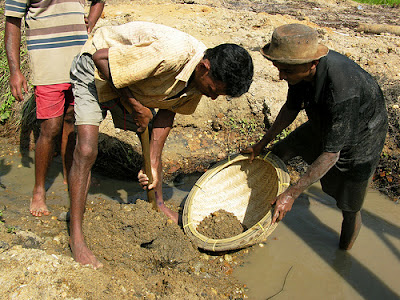Throughout history, Sri Lanka has been known as a land of gems. King Solomon was said to have procured a great ruby for the queen of Sheba from Ceylon (Sri Lanka's former name). Marco Polo (1293 AD) wrote about the ruby that once graced the Ruwanweliseya Dagoba at Anuradhapura..."a flawless ruby a span long and quite as thick as a man's fist".
Sri Lanka has produced three of the world's largest blue sapphires, including the 'Blue Bell' which adorns the British crown and the 'Star of India', displayed at the New York Museum of Natural History.
A visit to one of the museums or many gem workshops will give you the opportunity to see a variety of precious stone, such as rubies, sapphires, cat's eyes, alexandrites, aquamarines, tourmalines, spinels, topaz, garnets, amethyst, zircons etc. You could also visit one of the gem mines.
Temple in the sky
Ratnapura is situated at the foot of the 2243 metre high Adam's Peak. All four major religions claim Adam's Peak as a holy mountain. Buddhists call the mountain Sri Pada (the sacred footprint), or Samanalakande (Butterfly Mountain) and believe the Lord Buddha has visited the mountain and set his sacred footprint. Hindu's say it's Lord Shiva's and Muslims believe that it is the place where Adam first set foot on earth, after being cast out of heaven. Catholics say it is of St. Thomas' the Christian Apostle who preached in South India.
Ratnapura is also the staring point for the 'Classic' Hard route up Adam's Peak, via Gilimale and Carney estate. The Pilgrimage season starts on Poya (full moon) day in December and runs until the start of the South-West Monsoon in April. It has been a pilgrimage centre for over a 1000 years. King Parakramabahu and King Nissanka Malla of Polonnaruwa provided ambalamas or 'resting places' for weary pilgrims along the mountain route. The other more popular route is through Dalhousie (pronounced 'Del-house') close to Dickoya. Other routes to Adam's Peak.
View Larger Map




















